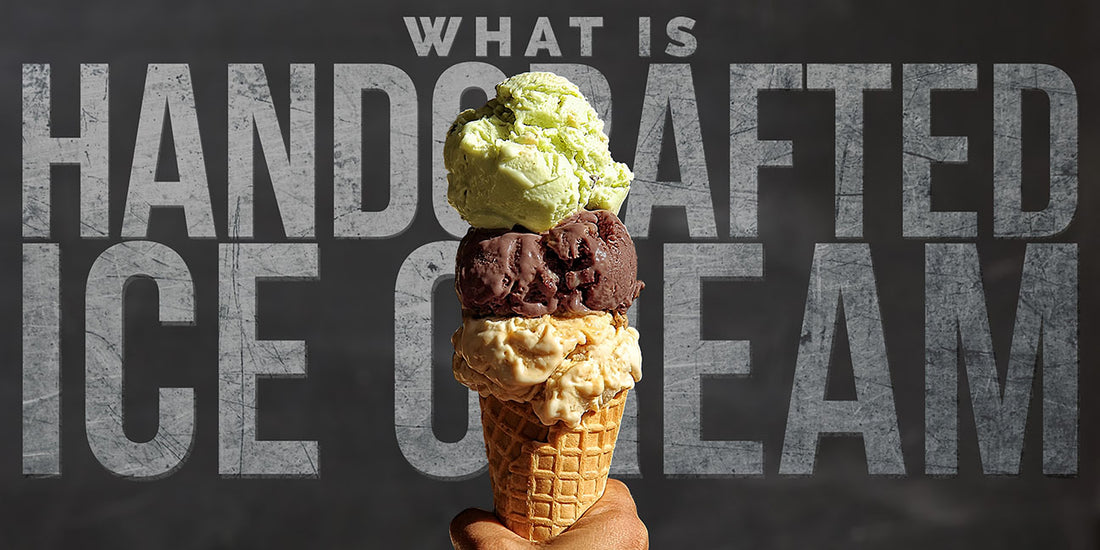If you’ve tried our high-quality handcrafted carabao milk ice cream at the Greenfield Weekend Market (or ordered it for delivery online) you can no doubt taste the difference from the readily available cheap, commercially made ice cream. If you haven't tried handcrafted or artisanal ice cream you’ve may have also wondered why you’re paying so much more. Well I hope with this three-part blog post, I can explain the differences between handcrafted and commercial ice cream and shed light on this matter.

Figure 1 - At the Greenfield Weekend Market, our customers do not 'taste with their eyes', instead we encourage them to taste, really taste, our available flavors as they like at the pop-up scoop shop before making their final choice.
The difference between the two types of ice cream, come down to three key differences: process, ingredients and distribution. This week. we discuss:
The Process - How Handcrafted Ice Cream is Made
Small-Batch versus Match Production
Handcrafted ice cream is made in small batches, rather than in giant machines on an assembly line as commercial ice cream is made. For us, we make ice cream only four quarts at a time in our traditional natural wood-Barrel Ice-Cream Maker (see Figure 1).

Figure 2 - Ad for a wood barrel White Mountain Freezer (Triple Motion) The “World's Best” Ice Cream Freezer, 1916. (Source: Wikimedia Commons, The Boston cooking-school cook book, Boston, Little, Brown, and Company, 1916)
We use ice and rock salt (lots of it) to bring down the temperature of the barrel, while we hand-crank to slowly-churn (or homogenize) the ingredients into ice cream. In fact all ice cream started out as this way or “handcrafted”, until the turn of the 20th century when it was commercialized and ice cream began to be manufactured in large bulk quantities at big factories.
Because of this, handcrafted ice cream is made more frequently so it’s always fresh and delicious.

Figure 3 - We use our wood-barrel ice cream maker to slowly-churn (or homogenize) the ingredients into ice cream.
Commercial ice cream are made in large industrial bulk quantities in factories using machines called continuous freezers. Continuous freezers using liquid ammonia to cool are automated and produce endless ice cream without interruption, pumping high volumes of air into their ice cream mix as it freezes, increasing its volume to produce ice cream.
What is overrun in ice cream?
This is what is in the ice cream industry called “overrun” or “the amount of air pushed into the ice cream while it is being made.” Air is an essential component of ice cream, and all ice cream have some degree of overrun in them (without air, ice cream would lose its characteristic "fluffiness" and and would be similar to a frozen ice cube). Handcrafted ice cream like ours usually have less than 40% overrun because of the slow-churning process we use.
Commercial ice cream usually has an overrun of 100% which means that the ice cream is made with one part air to every one part cream (or the air makes up 50 % of the ice cream volume). This means that they have a great deal of air whipped into them and that dramatically reduces the intensity of the taste. Production of ice cream with high overrun is a tool for cost savings and more profit, and this is mainly why ice cream produced this way is way more affordable.

Figure 4 - Ice cream is an very complex and delicate substance that contains all three states of matter at once: solid (ice and fat), liquid (sugar solution) and gas (air bubbles).
So you might be wondering what this has to do with the ice cream you eat, well it’s because the lower the overrun, the creamier, smoother and richer the ice cream tastes. Less air translates to fewer ice crystals, and fewer ice crystals means you’ll enjoy that melt-in-your-mouth creaminess that true artisanal ice cream gives and not anywhere else. Since commercial ice cream pumps more air into their ice cream, these ice cream manufacturers have to use artificial ingredients to ‘simulate’ or bring back that “melt-in-your -mouth” creaminess feel which they lost during the pumping air to their ice cream mix to cut on cost (I’ll get into greater detail on these additives in next week’s blog post on Ingredients).
Haven’t you ever wondered why you can finish a pint (or half-gallon) of commercial ice cream so easily? Because at a 100% overrun, you just actually finished half-a-pint of ice cream (because the rest was air). Try doing that do a pint of handcrafted ice cream, were pretty sure you’ll be satisfied and filled since our ice cream has less air than the supermarket bought one.
Also, next time you’re at the supermarket you can try to feel this difference when you pick up the pints of ice cream: higher-quality ice creams weigh more than their lower-quality counterparts.
---
Next week, in Part Two of “What is handcrafted ice cream and why is it better?” blog series, I’ll discuss the second key difference (and personally what my husband and I obsess about when we create our recipes) of handcrafted ice cream: The Ingredients.
If you found this article informative and useful, I hope you'll share it with someone who has the same passion for ice cream like us.
See you next week. Ciao.


